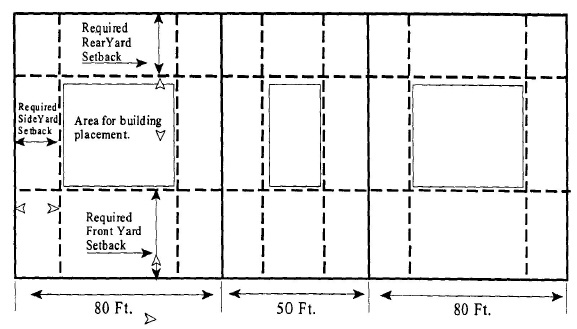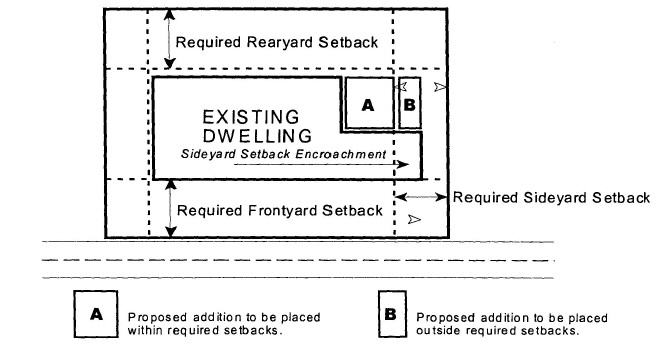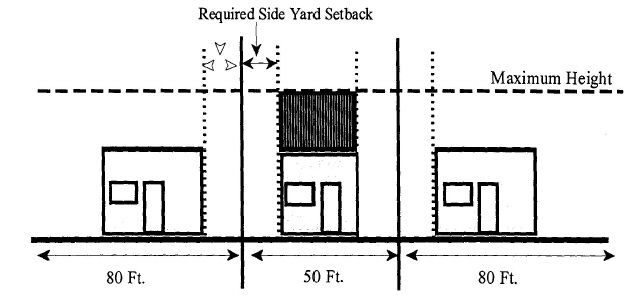Nonconforming lots, structures and uses, so long as they exist, prevent the full realization of the goals and objectives of the City of Saugatuck Master Plan and the objectives of this chapter. Upon the adoption of this chapter or subsequent amendments, there are lots, structures and uses of land and structures which were lawful prior to the adoption of this chapter, or the relevant amendment thereto, but which are not now in conformance. It is the intent of this chapter to permit these lawful nonconforming lots, structures and uses to continue but, with the exception of nonconforming residential structures, not to encourage their prolonged existence.
(A) Nonconforming lots.
(1) Existing lot of record. In any zoning district where an existing lot of record fails to meet the requirements for minimum lot area, minimum lot width or both, of the zoning district in which it is located, the lot may be used for the uses in the zoning district, provided that any structures comply with the required front, side, and rear yard setbacks of the zoning district; provided, however, that the foregoing shall not apply to a nonconforming lot abutted by another lot or lots under the same ownership. The zone district requires a minimum lot width of 80 feet. The undersized lot of 50 feet is a legal nonconforming parcel. The lot may be used to accommodate a permitted building provided all setbacks are complied with. A variance is not required.
Example: Nonconforming Lot

(2) Abutting lots of record under single ownership. In any zoning district, where two or more abutting lots of record in the same ownership do not, when considered individually, meet the requirements for minimum lot area, lot width, or both, of the zoning district in which the lot is located, prior to development any such lots shall be combined and considered as one lot for the purposes of this chapter. Where abutting lots of record which have been combined fail to meet the requirements for minimum lot area, lot width, or both, of the zoning district in which the combined lot is located, the combined lot may be used for uses allowed in the zoning district, provided that the required front, side and rear yard setbacks of the zoning district are complied with.
(B) Nonconforming uses of land not involving a building or structure. The lawful use of any land, not involving a building or structure, existing and lawful on the effective date of this chapter, or amendment thereto, may be continued, even though the use does not conform with the provisions of this chapter, or amendment thereto, subject to the following provisions:
(1) Enlargement. A lawful nonconforming use shall not be enlarged, increased or extended to occupy a greater area of land than was occupied on the effective date of this chapter, or amendment thereto;
(2) Relocation. A lawful nonconforming use shall not be moved in whole or in part to any other portion of the lot occupied by such use on the effective date of this chapter, or amendment thereto; and
(3) Cessation. If the property owner or lessee stipulates that any such nonconforming use of land will be discontinued, or if any such nonconforming use of land ceases or is abandoned for any reason for a period of one year, any subsequent use of the land shall conform to the requirements of this chapter. The occurrence of one or more of the following conditions shall be deemed to constitute an intent on the part of the property owner or lessee to cease, discontinue and/or abandon the nonconforming use:
(a) Utilities, such as water, gas and electricity to the property have been disconnected;
(b) Signs or other indications of the existence of the nonconforming use have been removed;
(c) Equipment or fixtures necessary for the operation of the nonconforming use have been removed;
(d) The property and/or grounds have not been maintained and/or have fallen into disrepair; and
(e) Other actions which, in the opinion of the Zoning Administrator, evidence an intention on the part of the property owner or lessee to abandon the nonconforming use of the land.
(C) Nonconforming structures. Use of structures which are existing and lawful on the effective date of this chapter, or amendment thereto, may be continued, even though the structures do not conform with the provisions of this chapter, or amendment thereto, subject to the following provisions.
(1) Enlargement or alteration.
(a) A lawful nonconforming structure may not be enlarged, expanded or altered in any way which increases its nonconformity with the provisions of this chapter unless otherwise noted within this chapter. The nonconforming structure may be enlarged or altered provided that all such changes are in conformance with all provisions of this chapter at every structural level. All enlargements or alterations shall be subject to review and approval by the Zoning Administrator.
(b) Pursuant to the above, the Zoning Administrator may require the applicant to provide boundary and/or topographic surveys of the existing nonconforming structure and associated site. These surveys shall be sealed by a registered land surveyor registered in the State of Michigan. The topographic survey may be limited to providing dimensional detail on the height of existing structures, unless additional information is required by the Zoning Administrator.
(c) The surveys shall verify that the existing setbacks and height limit of the existing nonconforming structure comply with the setbacks and height standards of the underlying zone district. Further, the survey drawing shall be used to identify the specific area, with dimensions, to be occupied by the expansion or alteration of the nonconforming structure.
Example: Nonconforming Residential Structure

The existing dwelling encroaches on a required side yard setback resulting in a nonconforming situation. Proposed addition "A" may be permitted following a residential site plan review by the Planning Commission. However, a variance from the Zoning Board of Appeals would be required for addition "B".
(3) ZBA conditions pursuant to enlargement/alteration. In authorizing a variance to enlarge or alter a lawful nonconforming structure, the Zoning Board of Appeals may impose conditions necessitated by the request including, but not limited to: additional site landscaping; site buffers; fencing; facade design requirements, building materials and building color changes; additional off-street parking and vehicular circulation modifications; signage; exterior lighting; and related building and site design modifications and conditions.
Example: Structural Alteration on a Nonconforming Lot
The zone district requires a minimum lot width of 80 feet. The undersized lot of 50 feet is a legal nonconforming parcel. The lot may be used to accommodate a permitted building provided all setbacks are complied with. In the following example, the undersized lot meets all building setbacks. The applicant wishes to increase the height of the structure. He or she may do so provided the upper story remains within all setbacks and height limits. A variance is not required.

(4) Damage and reconstruction.
(a) Nonconforming structure. In the event that any lawful, nonconforming, structure shall be damaged or destroyed by fire, wind, accident, act of God, or other similar means or manner, or threatened by flood, reconstruction, restoration, and/or raising shall be permitted by right, unless such destruction or damage was due to the intentional or reckless act or actions of an owner of the property. A structure to be reconstructed or restored shall be located within the original dimensions at every structural level, and/or within the original gross finished floor area, including decks and patios, with the exception that no portion of the structure shall be reconstructed within, or so as to encroach on, a public right-of-way or public easement. In addition, a structure to be reconstructed, restored, or raised within a designated special flood hazard area shall be located within the original dimensions at every structural level, and/or within the original gross finished floor area, including decks and patios, and shall further conform to the State Construction Code. Any reconstruction shall be subject to compliance with the provisions of this chapter, and any expansion shall be in full conformance with the requirements of the zoning district.
(b) Building permit required. Any reconstruction or restoration authorized pursuant to this division shall require the issuance of a building permit within 12 months of the occurrence of the damage.
(c) Special flood hazard area. For purposes of this division, threatened by flood shall mean that the structure is located in the special flood hazard area as designated in the current Flood Insurance Rate Map (FIRM) and the lowest floor level is less than one foot above the Base Flood Elevation (BFE) as designated in the FIRM. In addition, a structure that is threatened by flood shall not be raised more than three feet above the BFE.
(5) Decrease of nonconformity and re-establishment. If a lawful nonconforming structure is altered or modified so as to eliminate, remove or lessen any or all of its nonconforming characteristics, then those nonconforming characteristics shall not be later re-established or increased.
(D) Nonconforming use of structure. The lawful use of any structure existing and lawful on the effective date of this chapter, or amendment thereto, may be continued, even though the use does not conform with the provisions of this chapter, or amendment thereto, subject to the following provisions:
(1) Extending use within a structure. Any lawful nonconforming use may be extended throughout any internal parts of a building which were manifestly arranged or designed for such use at the effective date of this chapter, or amendment thereto, but no such use shall be extended to occupy any portion of a building which was not manifestly arranged or designed for the use at the effective date of this chapter, or amendment thereto, nor shall the use be extended to occupy any land or air space outside the building.
(2) Alteration of structure possessing a nonconforming use. No existing structure devoted to a lawful nonconforming use shall be enlarged, extended, constructed, reconstructed, moved or structurally altered except in changing the use of the structure to a use permitted in the zoning district in which it is located.
(3) Reconstruction of structure occupied by a nonconforming use. If a structure which conforms with the provisions of this chapter, but which is occupied by a lawful nonconforming use, is damaged by any means or in any manner to the extent that the value of reconstruction or restoration exceeds one-half the value of the structure prior to the damaging occurrence, as determined by the most recent city assessment of the value of the structure, excluding the value of the land, for purposes of taxation, the structure may be reconstructed or restored only if its use conforms with the provisions of this chapter.
(4) Re-establishment of nonconforming use. If a lawful nonconforming use of any structure is terminated and replaced by a permitted use, the nonconforming use shall not be later re-established.
(5) Cessation. If the property owner or lessee stipulates that a lawful nonconforming use of a structure or structure and land in combination will be discontinued, or if any such nonconforming use of a structure, or structure and land in combination, ceases for any reason for a period of more than 12 months, any subsequent use of the structure shall conform to regulations of the zoning district in which it is located. The occurrence of one or more of the following conditions shall be deemed to evidence an intent on the part of the property owner or lessee to cease, discontinue and/or abandon the nonconforming use:
(a) Utilities, such as water, gas and electricity to the property have been disconnected;
(b) Signs or other indications of the existence of the nonconforming use have been removed;
(c) Equipment or fixtures necessary for the operation of the nonconforming use have been removed;
(d) The property, buildings and/or grounds have not been maintained and/or have fallen into disrepair; and/or
(e) Other actions which, in the opinion of the Zoning Administrator, constitute an intention on the part of the property owner or lessee to abandon the nonconforming use of the structure or structure and land in combination.
(6) Removal of nonconforming use status after removal or destruction of building. Where lawful nonconforming use status applies to a structure and land in combination, removal or destruction of the structure shall eliminate the nonconforming use status of the land.
(7) Change in use (substitution).
(a) A lawful nonconforming use of a structure may be changed to another nonconforming use only if functionally similar to the previous non-conforming use. Application for a change in use shall require approval of the Zoning Board of Appeals. The Board may approve the change only if it complies with all of the following standards:
1. The proposed use does not increase the degree of nonconformity existing prior to the change of use. Pursuant to this standard, the proposed use shall not create, or result in, impacts which are considered more objectionable than the use to be replaced. These impacts shall include, but are not limited to, increased traffic, truck deliveries, parking requirements, hours of operation, noise, vibration, odors, litter, outside storage, pedestrian movement, off-site drainage and other factors.
2. No structural alteration of the existing structure will be required to accommodate the new use, unless the alteration will bring the structure into greater conformity with the underlying zone district standards.
(b) In approving a change in use, the Board may require reasonable conditions in order to decrease the impact on adjoining properties. These conditions may include, but are not limited to, buffers, landscaping, off-street parking, access controls, hours of operation and other such conditions to reduce any negative impact.
(E) Basic repairs and maintenance.
(1) Basic repairs and maintenance. On any structure devoted in whole or in part to any lawful nonconforming use, work may be done in any period of 12 consecutive months on ordinary repairs, or on repair or replacement of non-bearing walls, fixtures, wiring, mechanical equipment or plumbing to an extent not exceeding 20% of the current replacement value of the structure as based on the records of the City Assessor, provided that the structure is not enlarged, extended, moved or structurally altered unless otherwise provided for by this chapter.
(2) Safety improvements. Nothing in this chapter shall be deemed to prevent the strengthening or restoring to a safe condition of any structure or part thereof declared to be unsafe by any official charged with protecting the public health, upon order of the official.
(F) Structures under construction. Any structure on which actual construction was lawfully begun prior to the effective date of this chapter, or amendment thereto, but which, under this chapter or amendment thereto, is classified as nonconforming, shall be considered existing and legally nonconforming pursuant to construction purposes and the intended use. Nothing in this chapter shall be deemed to require any change in the plans, construction or use of the structure. Actual construction is hereby defined to include the placing of construction materials in a permanent position and fastened in a permanent manner, except that where demolition or removal of an existing building has been substantially begun preparatory to reconstruction the demolition or removal shall be deemed actual construction.
(G) Nonconforming special land uses.
(1) There were uses which were permitted by right under Ord. 80-133 which are not permitted uses under this chapter. Those existing uses which were permitted uses and are listed as special land uses in this chapter shall not be considered nonconforming uses.
(2) Those uses, or parts of uses, which existed as permitted uses under Ord. 80-133 and are listed as special land uses in this chapter, shall be considered to be approved existing special land uses with the configuration shown on a site plan drawn to reflect how the uses existed at the time of adoption of this chapter. Parts of uses which are nonconforming immediately prior to the adoption of this chapter shall continue to be nonconforming under this chapter.
(3) An owner of an approved existing special land use permit may obtain from the Commission a certification of site plan reflecting how the use exists at the time of adoption of this chapter with identification of nonconforming parts, if any. In the case of disputes over facts on what existed at the time of adoption of this chapter, aerial photographs, flown in the city by the county or other aerial photographs, flown to the same or greater standards for mapping as the county’s photos, taken after the county photos but before the adoption of this chapter, shall be given the greatest weight as evidence to establish a certified site plan. For purposes of this section, the above mentioned photos may be accepted as the site plan for the written special use permit.
(4) When a special use owner applies to amend the approved existing special use for expansion or change, a written special use permit shall be prepared for the entire use and parcel. In review of the special use permit amendment application for expansion or change, the Commission shall only review and act on the expansion or change portion of the special use permit. If the application for amendment of the special use permit is approved, approved with conditions, denied or denied in part, the action shall not change or alter those parts of the special use that are shown on the approved existing special use permit.
(H) Purchase and condemnation of nonconforming uses and structures. Subject to the provisions of state law, the city may acquire by purchase, condemnation or other means private property, or an interest in private property, for the removal of nonconforming uses and structures.
(Ord. 02-02, passed 2-11-2002; Am. Ord. passed 9-8-2003; Am. Ord. 091123-1, passed 11-23-2009; Am. Ord. 111212-1, passed 12-12-2011; Am. Ord. 141208-1, passed 12-8-2014; Am. Ord. 201109-C, passed 11-9-2020)